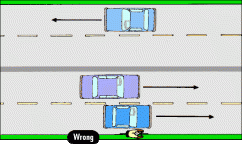A bicyclist in Minneapolis gets hit from behind by a driver and is critically injured. Local news coverage focuses on the police statement that said she was riding in the “proper location.” Parson my French, but WTF does that mean?
From the Star Tribune article:
[She] was riding “on the right side of the right lane” at the time the car hit her from behind, said Police spokesman John Elder, who added that her position was correct for that stretch of road. There is no sidewalk on eastbound Excelsior for bicyclists to use.
Paul Walsh, you know, I wasn’t planning on knowing your journalism so well but I am sorry to say this is strike two in journalism coverage on bicyclist crashes with drivers of cars. Strike one: your coverage on Marcus Nalls (review my commentary if needed).
As Lauryn Hill so eloquently says, let’s break it down for you again:
- Bicyclists have the right to a full lane. The victim could have been riding in the middle of the lane, on the left side of the lane, passing into another lane. We get it all! The whole lane! And we get to pass into other lanes (with signaling, of course).
 Never mind that riding in the right side of the right lane is actually the most dangerous because drivers think they can scoot around you and then almost side swipe you.
Never mind that riding in the right side of the right lane is actually the most dangerous because drivers think they can scoot around you and then almost side swipe you.
Oh the times I could count this happening to me. Bicycle educators insist that riding in the middle of the lane is the safest for all people on the street. - No sidewalk to ride on? No sidewalk?! Oh police spokesperson Elder, you silly guy. Bicyclists should not ride on the sidewalk. Whether there was a sidewalk is completely irrelevant to this crash. Why Walsh reported this, I have no idea. It is really dangerous to ride your bicycle on the sidewalk.
 Drivers don’t expect to see you there and…just don’t do it. I can’t even explain this anymore. Fun trivia fact: In Minneapolis, police hand out more citations for riding on the sidewalk than any other bicycle-related no-no.
Drivers don’t expect to see you there and…just don’t do it. I can’t even explain this anymore. Fun trivia fact: In Minneapolis, police hand out more citations for riding on the sidewalk than any other bicycle-related no-no. - By reporting on the “proper” biking of the victim, you are arguing that only proper biking can result in a blameless outcome. If the victim wasn’t in the proper location (whatever that means), would you then be blaming her for her own critical injuries? And if so, what would that blaming bring us? What help would that be to her? To bicycle safety writ large? Does the driver thus have no responsibility?
- Why don’t you report on the driver? The lead is the most important sentence in a news story (yeah, don’t test me, I am a journalism prof), and this is what you ran with. Ok, so for a more objective piece I suggest reporting on the driver’s location. They clearly were not in the proper location because they rode right into the bicyclist. Did you ask Elder if the driver was on their phone?
Under the influence?(Ok, you at least got that one) Yapping with their friend in the car? Turning the dial on the radio? - You are spreading really awful ideas about what it means to be a bicyclist. Your article is currently the most read on the Star Tribune website (5 p.m. on a Monday night). So many people are reading this dangerous framework that the bicyclist is only let off the hook of blame for her critical injuries because she was properly riding. Otherwise, hey it is fair game to blame the heck out of her for bicycling improperly. Do we do this kind of vetting for drivers? Doesn’t seem like it. You have a big voice with many eyeballs on you. Use that voice ethically and responsibly.
Paul Walsh, it feels like only yesterday that I wrote an almost identical post about your reporting on bicyclists (Marcus Nalls being “careful”). What gives, man? How can we help?
Free idea: Report on how dangerous it is to ride a bicycle in parts of this city and the continual threat that distracted driving has on all of us.

My thoughts go out to the victim (who I am not re-naming because of the trigger that can bring people who know her).





